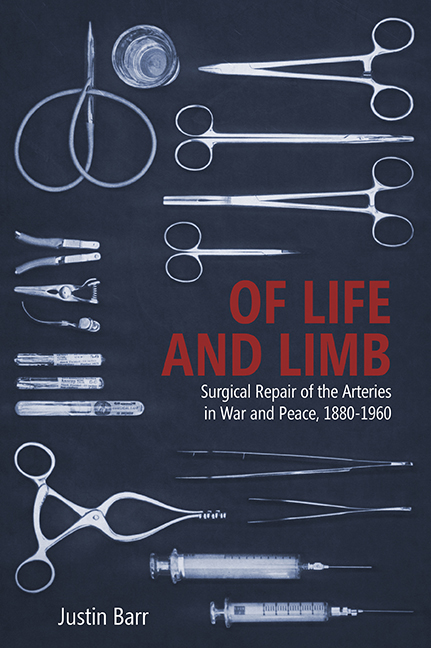 Surgical Repair of the Arteries in War and Peace, 1880–1960
Surgical Repair of the Arteries in War and Peace, 1880–1960 Book contents
- Frontmatter
- Contents
- Acknowledgments
- Introduction
- 1 Technical Change, Practical Stasis: The Development of Arterial Repair through 1914
- 2 An Ideal Rarely Practiced: Arterial Repair and Its Alternatives from World War I to World War II
- 3 Opportunities Realized and Discarded: The Management of Vascular Trauma in World War II
- 4 Reshaping Surgical Infrastructure between World War II and the Korean War
- 5 An Ideal Implemented: Arterial Repair in the Korean War
- 6 Bringing It All Back Home
- Conclusion: Arterial Repair and the Process of Surgical Change
- Notes
- Bibliography
- Index
5 - An Ideal Implemented: Arterial Repair in the Korean War
Published online by Cambridge University Press: 29 March 2020
- Frontmatter
- Contents
- Acknowledgments
- Introduction
- 1 Technical Change, Practical Stasis: The Development of Arterial Repair through 1914
- 2 An Ideal Rarely Practiced: Arterial Repair and Its Alternatives from World War I to World War II
- 3 Opportunities Realized and Discarded: The Management of Vascular Trauma in World War II
- 4 Reshaping Surgical Infrastructure between World War II and the Korean War
- 5 An Ideal Implemented: Arterial Repair in the Korean War
- 6 Bringing It All Back Home
- Conclusion: Arterial Repair and the Process of Surgical Change
- Notes
- Bibliography
- Index
Summary
The Korean War transformed vascular surgery from a practice based primarily on ligation to one of arterial repair. Bookended by the global cataclysm of World War II and the society-wrenching quagmire in Vietnam, Korea has suffered from inattention in lay and academic sources alike. This disregard extends to the medical and scientific aspects of the conflict. Yet the war proved crucial for establishing arterial repair as the standard of care for traumatic injuries to blood vessels. This sea change in vascular surgery over the course of three years of fighting demonstrates the importance of the particular milieu of the Korean War. The nature of combat, with relatively stable lines by 1951, total control of the air, and a robust supply chain created conditions amenable to surgical innovation while still resulting in the thousands of casualties needed to improve vascular management. Uniformed clinicians retained the freedom to experiment. Medical advances such as more powerful antibiotics, massive blood transfusions, artificial kidneys, and more advanced anesthesia care helped keep the wounded alive to and through prolonged operations. A cadre of young, bold, residency-trained surgeons capitalized on these circumstances to repair arteries in ever increasing numbers.
Seesawing to Stability: Brief Military History of the Korean War
Dramatically different from the totality of World Wars I and II, the comparatively limited engagement in Korea against technologically inferior foes fostered an environment conducive to medical innovation. After largely escaping the destruction of World War II, Korea fell prey to international politics that artificially divided the peninsula into a Communist north under Soviet influence and an anti-Communist south backed by the United States. Leaders of both North and South Korea wanted to unify the country under their rule. On 25 June 1950, the North Korean army launched a surprise attack across the 38th parallel. With South Korean forces reeling in retreat and Western fears of a domino effect in full bloom, the United Nations voted to dispatch an international force to defend the South.
The war proceeded in four distinct stages (figure 5.1). First, North Korean armies drove UN forces south into a desperately defended position, the Pusan Perimeter. The peninsula of Korea both hemmed in UN forces while also limiting fighting to a discrete geographic area.
- Type
- Chapter
- Information
- Surgical Repair of the Arteries in War and Peace, 1880–1960Surgical Repair of the Arteries in War and Peace, 1880–1960, pp. 106 - 136Publisher: Boydell & BrewerPrint publication year: 2019


